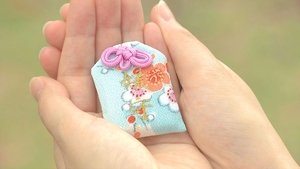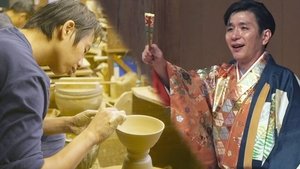All Available Episode
All Season 8 Episode

1. New Wave Dyeing: The Challenge for Innovation Within Tradition
With kimono no longer everyday attire, Kyoto's dyeing industry faces decline. But people are taking on the challenge of ensuring the traditional techniques will survive. An artist specializing in Katazome stencil dyeing evokes distinctive worlds with profound, vibrant hues, unattainable with brushes and paint. An artisan has introduced 3D printing to Kyo-kanoko tie-dyeing for a fresh perspective. Discover the new wave of innovation bringing today's traditional dyeing culture into the future.

2. Popular Noh: A Spiritual Art Fosters Connections
The performing art of Noh has a history stretching back more than 600 years and is registered on UNESCO's list of the Intangible Cultural Heritage of Humanity. Masked actors in sumptuous costumes use dance to convey stories of ghosts seeking salvation, with dialog and narration sung to musical accompaniment. These ancient spiritual stories still speak to people today. Discover a popular form of theater through Kyoto's many amateur performers and the professionals who want to spread its appeal.

3. The Culture of Gift Giving: Beautiful Etiquette Strengthens Relationships
A girl in her first year receives dolls representing an emperor and empress. People give each other Senmaizuke turnip pickles at year's end. In December, maiko present their dance teachers with mochi rice cakes and receive folding fans in return. In Kyoto, the custom of giving gifts at milestones and at the change of seasons has its origins in ancient court ceremonies that express gratitude and celebration. Discover the Kyoto culture of building and maintaining relationships through gift giving.

4. Bamboo Innovation: Creative, Pliable and Sustainable
Bamboo has long been used in architecture and everyday tools. Today the Kyoto bamboo industry is in decline due to lifestyle changes and the lack of bamboo craftsmen. One artisan uses traditional methods to create fashion accessories. A fence builder promotes bamboo through QR codes and artworks. A master craftsman developed fireproof bamboo and nurtures new talent to expand his market. Discover how the younger generation is working to revive interest in bamboo by infusing modern sensibilities.

5. Kyoto Accessories: Wearable Works of Art
Women in Kyoto through the ages, like their counterparts around the world, have always desired the most beautiful and impressive fashion accessories to complement their outfits. Today, artisans from various fields are applying their respective traditional crafts to produce unusual, vogue adornments. The results range from sophisticated to adorable, with each embodying the refined quality Kyoto is known for. Discover craftspeople who expand their creativity through their wearable works of art.

6. Kyoto Glasswork: The Elegant Sparkle of Craftsmanship
Glass arrived in Japan with the Christian missionaries in the 16th century. Kyoto aristocrats, high-ranking samurai and wealthy merchants used the much-prized foreign glassware as a gesture of hospitality toward guests. Today, locally-made glassware continues to evolve within the fields of cookery, art and the sciences. Various materials are fused with precision and rustic sensibilities. Discover the essence of Kyoto values and aesthetic sensibilities through the works of master glassmakers.

7. Kyoto Amulets: The Embodiment of Prayers for Happiness
Kyoto is dotted with Buddhist temples and Shinto shrines offering amulets for health, longevity, safety, easy childbirth and other blessings. An amulet warding off an epidemic centuries ago now eases Kyotoites' anxiety in the age of COVID-19. But amulets change with the times. A card that slips into a wallet and a microSD containing a Buddhist image for uploading to a mobile device keep the deities' spirits close by. Discover the charm of amulets through their history and their creation process.

8. Fudo Myo-o: The Enduring Power of a Wrathful Deity
Flames rising from behind, piercing eyes and an enraged expression, statues of Fudo Myo-o hold a sword and lasso, both ritual implements. Despite its formidable appearance, this deity has a wide following among devotees and common folk alike. The solid power it emits has attracted many people craving comfort during the coronavirus pandemic. Discover the faith and customs surrounding Fudo Myo-o, and the undertakings of a monk cum Buddhist sculptor who is captivated by this protective guardian.

9. Nouveau Confections: A Feast for the Eyes, Mouth, and Mind
As the traditional confectionery industry wanes due to a growing preference for Western-style sweets, the younger generation of confectioners are using modern sensibilities to attract consumers. Some use only organic ingredients. Others create dry confections with pop designs. A heritage confectioner delivers fresh sweets for people to enjoy the seasons at home. A cafe serves the unthinkable pairing of Kyoto confections with sake. Discover how these innovative approaches invigorate tradition.

10. Vogue Kimono: Fashion in Evolution
Designers and kimono-lovers are sparking a kimono revolution in imaginative ways. They weave global tastes into orthodox fabrics, coordinate kimono with Western-style clothing, and adventurously employ materials from different fields into this time-honored Japanese attire. They are also testing new approaches so they can ride out the pandemic. Discover how the evolution of the kimono is spurred on by bold designers drawing on aspects of Kyoto sensibilities and traditional craftsmanship.

11. Ogawa Jihei Gardens: Beauty Soothes and Nourishes the Soul
From the late 1800's to the early 1900's, dominant political and business figures owned villas in neighborhoods at the foot of the Higashiyama mountains. Many of their gardens were built by the pioneer of the modern Japanese garden, Ogawa Jihei VII. While Kyoto's cityscape was transforming after the fall of feudalism, Jihei designed spaces of comfort in a desire to return Kyoto to its glory days of scenic beauty. Discover natural spaces of calculated beauty that offer solace during the pandemic.

12. The Double Ninth Festival: Beautiful Chrysanthemums Grant Longevity
The five seasonal festivals to drive out evil originate in Yin and Yang philosophy. The most important is the Double Ninth festival on September 9, the largest, single-digit odd number. Chrysanthemums, a medicinal herb, are used for purification in the 1,000-year-old longevity rituals; hence, the festival's name. A chrysanthemum-boy doll, Noh plays, children's sumo, and floss-adorned chrysanthemums. Discover how the Chrysanthemum Festival has taken on new significance during the pandemic.

13. Conversations: A Potter and a Kyogen Actor
Two professionals from diverse fields, potter Matsubayashi Hosai and comic actor Shigeyama Sennojo discuss what it means to carry on a tradition and the similarities and differences between their professions. Born into 400-year-old Kyoto legacies, both have an eye on the international stage and are searching for ways to pass on the crafts and skills they inherited. Explore what roles people in heritage professions should play in 2020, at a time when lifestyles are changing due to the pandemic.

14. Miyamoto Musashi: Sword Mastery in the Ancient Capital
Through novels and movies, the name Miyamoto Musashi has become synonymous with the word "samurai." The undefeated, 17th-century swordsman was also a master of calligraphy, the way of tea, and other arts. In his later years, he wrote "The Book of Five Rings" to relate the wisdom he gained through his duels. His teachings act a guide to living a significant life and remain seminal today during the pandemic. Discover Musashi's Kyoto through people who feel a deep affiliation with his way of life.

15. Warding Off Epidemics: Heartfelt Prayers for Safety
With the spread of Covid-19 in 2020, many annual festivals were condensed. But Kitano Goryoe was revived at Kitano Tenmangu after a 550-year hiatus in prayer for an end to the pandemic. The joint Shinto-Buddhist rite was originally held to appease the deity of plagues and honor dignitaries who were tragically killed. From this, Gion Matsuri and other festivals similarly evolved over the centuries. Discover the Kyoto customs to eradicate epidemics through rites, amulets, dolls, and confections.

16. Nouveau Lacquerware: Vibrant Dazzling Beauty
Solid, durable and decorative, lacquer is a lustrous, natural polymer used in art, architecture, Buddhist statues, and everyday items. Kyoto was the seat of the emperor and aristocratic culture, so lacquerers always strove to out-dazzle each other and, in the process, refined their workmanship. Undeterred by difficulties they face from the pandemic, lacquerers today continue the art while searching for fresh ideas. Discover how they create the unconventional and innovative within the traditional.
